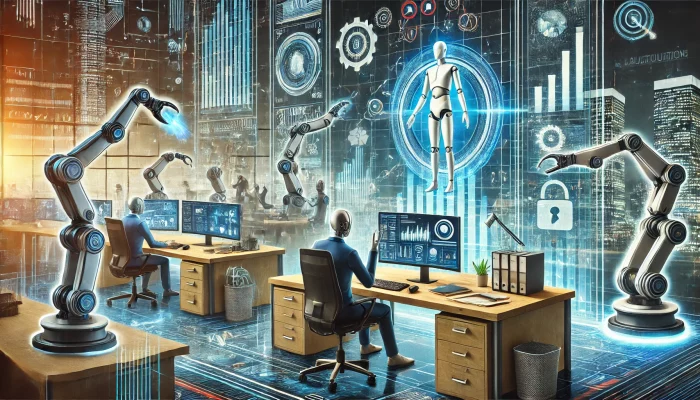The Transformation of Employment by Automation
The Challenge of Job Displacement
As automation advances, concerns about job losses are at the forefront. Machines are increasingly capable of performing tasks that are routine and repetitive, especially in sectors like manufacturing, logistics, and services. Research from the McKinsey Global Institute suggests that automation could render up to 800 million jobs obsolete by 2030, touching many sectors of the economy.
The Opportunity for Job Creation
Despite the potential for job loss, automation simultaneously paves the way for new job prospects. Emerging technologies give rise to sectors and roles previously non-existent. The tech sector’s expansion, for example, has brought about job functions including data scientists, cybersecurity analysts, and AI developers. The World Economic Forum estimates that while 75 million jobs might be displaced by 2022, there could be a creation of 133 million novel roles.
The Evolution within Existing Jobs
A multitude of current jobs will see a transformation. With automation boosting human abilities, workers can shift their focus to tasks of greater value that necessitate ingenuity, analytical thinking, and interpersonal skills. In healthcare, for example, AI’s role in data assessment frees doctors to enhance patient care time and attention.
The Changing Face of Job Roles
Skills in High Demand
A fresh skill set becomes imperative for the future job market. Technical abilities in AI, machine learning, data analytics, and robotics will be in great demand. Equally important will be soft skills such as problem-solving, flexibility, effective communication, and emotional intelligence, which are challenging for machines to mimic.
The Imperative of Lifelong Learning
The quickening pace of technological evolution mandates a commitment to lifelong learning. Workers will have to perpetually refine their expertise and knowledge base. This may involve a combination of formal schooling, digital courses, workshops, and practical training. Employers will be crucial in cultivating a learning culture and providing skill enhancement opportunities.
The Emergence of Hybrid Roles
With the merging of technological and human skills, hybrid roles will surface, demanding a mix of technical savvy and soft skills. For instance, a marketing expert may need to grasp data analytics to understand consumer patterns and develop focused campaigns, while a product manager might need to combine user experience design with AI proficiency.
The Shift in Workforce Structure
The Rise of Remote Work
The push towards remote work has been hastened by the COVID-19 pandemic. Technological advancements in communication and collaboration have enabled many jobs to be done from virtually anywhere. This trend is expected to persist, offering flexibility to employees and granting employers access to a wider talent pool.
The Expansion of the Gig Economy
The gig economy, with its freelance and short-term contract work, is on the rise. Automation supports this trend by powering platforms that match workers with employers for specific tasks. Although the gig economy allows for flexibility and independence, it also brings up issues related to job stability, employee benefits, and rights.
Organizational Change
Businesses must adjust to the evolving work landscape. This encompasses reimagining job roles, integrating novel technologies, and nurturing an innovative mindset. Firms that can use automation to boost efficiency while also investing in their workforce’s transitions will likely succeed.
Strategies for Success in the Automation Era
For Individuals:
- Commit to Continuous Learning: Keep skills and knowledge up to date to remain competitive.
- Build Technical Expertise: Acquire skills in AI, data analytics, and robotics.
- Strengthen Soft Skills: Develop abilities like problem-solving, communication, and empathy.
- Maintain Flexibility: Be open to new roles or sectors when opportunities arise.
For Organizations:
- Invest in Staff Development: Offer learning opportunities to help staff adapt.
- Utilize Technological Tools: Apply automation and AI to increase efficiency and augment human work.
- Cultivate an Innovative Environment: Promote a culture that embraces new ideas and technologies.
- Assist with Workforce Changes: Support employees affected by automation with reskilling and career help.
For Policymakers:
- Support Education and Training Initiatives: Invest in educational frameworks that prepare for the future workforce, emphasizing STEM and continuous learning.
- Bolster Social Safety Nets: Enhance support systems for those displaced by automation.
- Stimulate Innovation: Enact policies that encourage new business and job growth.
- Combat Inequality: Take action to reduce income disparities and distribute automation’s advantages equitably.
Conclusion
In the evolving landscape of employment, shaped by the advance of automation, we encounter a mix of obstacles and prospects. Although automation might render some positions obsolete, it simultaneously holds the capacity to forge novel occupations, revamp current ones, and magnify efficiency. The secret to prospering in this forthcoming epoch hinges on flexibility, incessant education, and the judicious amalgamation of technological advancements with the unique capabilities of humans. With adequate preparation for these shifts, people, enterprises, and legislative bodies can steer through this metamorphosis effectively and cultivate a realm of professional engagement that is equitable, pioneering, and enduring.

Leave a Reply